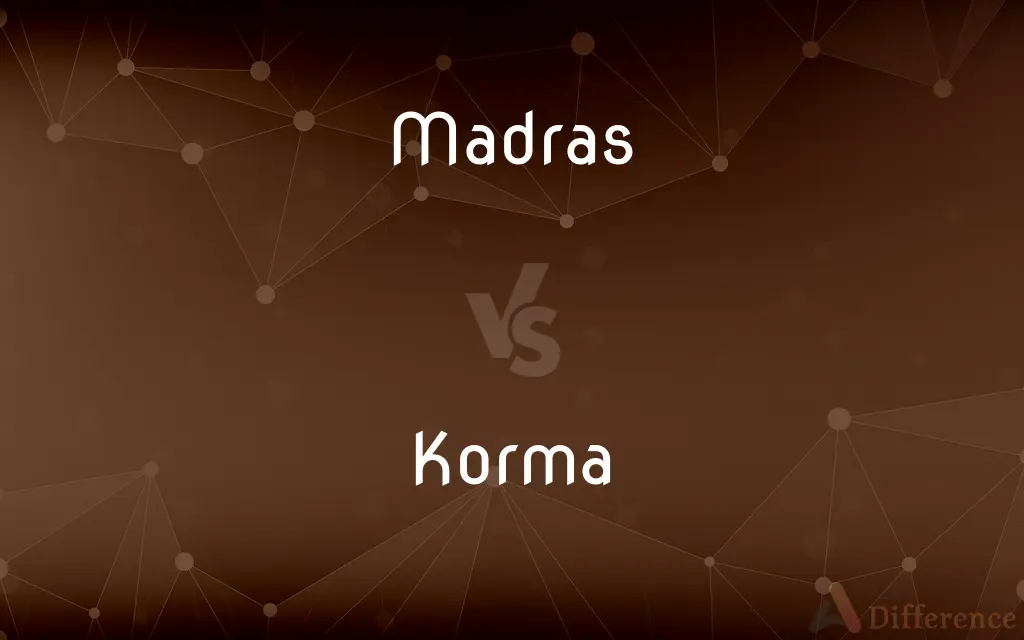Madras vs. Korma — What's the Difference?
Edited by Tayyaba Rehman — By Maham Liaqat — Updated on March 10, 2024
Madras and Korma are both types of Indian curries, but they differ significantly in flavor, ingredients, and heat level.

Difference Between Madras and Korma
Table of Contents
ADVERTISEMENT
Key Differences
Madras is a spicy curry that hails from the southern part of India, known for its rich red color and a high level of heat, typically achieved through the use of hot chili peppers. It often includes a blend of spices like cumin, coriander, and turmeric, giving it a bold, robust flavor. Korma, on the other hand, originates from the northern regions and is characterized by its creamy, mild, and subtly sweet flavor profile, achieved through the use of yogurt, cream, coconut milk, and ground nuts, with a blend of aromatic spices such as cardamom, cinnamon, and cloves.
The preparation of Madras curry often involves a tomato-based sauce, which contributes to its tangy flavor, and it may include meat, poultry, or vegetables. Korma is typically prepared with a yogurt-based marinade that tenderizes the meat (often chicken, lamb, or beef) and is slowly cooked to infuse the flavors of spices, nuts, and cream.
Madras curry is ideal for those who enjoy spicy and pungent dishes, while Korma is more suited to those who prefer milder and richer flavors. Despite their differences, both curries are often served with rice or Indian bread like naan or chapati to complement the flavors and manage the heat level, especially with Madras.
Culturally, Madras reflects the culinary traditions of South India, where the climate and local ingredients influence the cuisine's spiciness and bold flavors. Korma, with its roots in Mughlai cuisine, showcases the sophisticated blending of spices and the use of dairy products, which are hallmarks of North Indian cuisine.
Comparison Chart
Origin
Southern India
Northern India
ADVERTISEMENT
Flavor Profile
Spicy, bold, and tangy
Creamy, mild, and subtly sweet
Heat Level
High
Low to none
Base Ingredients
Chili peppers, tomatoes, cumin, coriander
Yogurt, cream, coconut milk, cardamom, cinnamon
Sauce
Tomato-based
Yogurt or cream-based
Typical Proteins
Meat, poultry, vegetables
Chicken, lamb, beef
Cultural Influence
Influenced by South Indian cuisine
Influenced by Mughlai (North Indian) cuisine
Compare with Definitions
Madras
A spicy curry known for its heat.
The Madras curry had a fiery taste that was both exhilarating and intense.
Korma
Features a blend of aromatic spices.
The korma had a subtle sweetness, thanks to the cardamom and cinnamon.
Madras
Often made with a variety of meats.
Chicken Madras is a popular choice for those who enjoy spicy food.
Korma
A mild, creamy curry with a rich texture.
The chicken korma was deliciously creamy and comforting.
Madras
Includes spices like cumin and coriander.
The blend of cumin and coriander in the Madras curry was aromatic and flavorful.
Korma
Often uses yogurt or cream for marination.
The meat in the korma was tender, thanks to the yogurt marinade.
Madras
Uses a tomato-based sauce for tanginess.
The tomatoes in the Madras curry added a delightful tang to its spicy profile.
Korma
Represents the Mughlai influence on cuisine.
The korma's rich, creamy sauce showcased its Mughlai culinary heritage.
Madras
Reflects the South Indian preference for heat.
True to its South Indian roots, the Madras curry was bold and spicy.
Korma
Typically includes ground nuts for thickness.
The smooth texture of the korma came from finely ground almonds.
Madras
Former name (until 1995) for Chennai
Korma
Korma or qorma is a dish originating in the Indian subcontinent, consisting of meat or vegetables braised with yogurt (dahi) or cream, water or stock, and spices to produce a thick sauce or gravy.
Madras
Former name (until 1968) for the state of Tamil Nadu
Korma
A dish of South Asian origin in which meat or vegetables are braised or simmered in a rich, highly seasoned sauce thickened with ground nuts, yogurt or cream, and sometimes coconut.
Madras
A lightweight, often plain-woven cotton cloth, usually with a plaid, striped, or checked pattern.
Korma
A curry made from various spices especially coriander and cumin; and often with yoghurt sauce or nuts.
Madras
A similar lightweight patterned cloth made of silk or rayon.
Madras
A large handkerchief of brightly colored silk or cotton, often worn as a turban.
Madras
A brightly colored cotton fabric with a checked or striped pattern.
Madras
A large handkerchief of this fabric, worn on the head in the West Indies.
Madras
A large silk-and-cotton kerchief, usually of bright colors, such as those often used by negroes for turbans.
A black woman in blue cotton gown, red-and-yellow madras turban . . . crouched against the wall.
Madras
A light patterned cotton fabric.
Madras
A state in southeastern India on the Bay of Bengal (south of Andhra Pradesh); formerly Madras
Madras
A city in Tamil Nadu on the Bay of Bengal; formerly Madras
Madras
A light patterned cotton cloth
Common Curiosities
Is Korma suitable for vegetarians?
Absolutely, Korma can be made with vegetables or paneer instead of meat.
Can Madras curry be made less spicy?
Yes, adjusting the amount of chili used can reduce the heat level in Madras curry.
Can dairy-free alternatives be used in Korma?
Yes, coconut milk can be a great dairy-free alternative for a creamy Korma.
What is the best way to serve Madras curry?
Madras curry is best served with rice or Indian bread to complement its spiciness.
How do the spices in Madras and Korma differ?
Madras focuses on heat and bold flavors with spices like chili, turmeric, and cumin, while Korma uses aromatic and sweet spices like cardamom and cloves.
Can the protein in these curries be substituted?
Yes, both curries are versatile and can be made with a variety of proteins, including seafood or plant-based options.
How does the cooking time differ between Madras and Korma?
Korma typically requires a longer, slower cooking process to blend the flavors, whereas Madras might be quicker due to the less complex sauce.
Are Madras and Korma gluten-free?
Generally, yes, but it's important to check individual recipes and ingredients, especially for thickening agents or cross-contamination in restaurants.
What side dishes complement Madras and Korma?
Lighter side dishes like raita or a simple salad can complement Madras, while for Korma, something tangy or with a bit of crunch would provide a nice contrast.
Is there a preferred time of year to enjoy these dishes?
Madras might be more suited to colder months due to its heat, while Korma's richness makes it a comforting choice year-round, but personal preference is key.
Share Your Discovery

Previous Comparison
Analyze vs. Analysis
Next Comparison
Shall vs. ShaltAuthor Spotlight
Written by
Maham LiaqatEdited by
Tayyaba RehmanTayyaba Rehman is a distinguished writer, currently serving as a primary contributor to askdifference.com. As a researcher in semantics and etymology, Tayyaba's passion for the complexity of languages and their distinctions has found a perfect home on the platform. Tayyaba delves into the intricacies of language, distinguishing between commonly confused words and phrases, thereby providing clarity for readers worldwide.














































